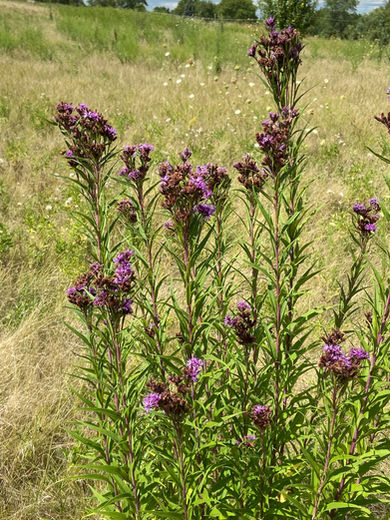Prairie Ironweed
Common Name: Prairie Ironweed.
Scientific Name: Vernonia Fasciculata.
What to look for? Clusters of lovely magenta, tubular flowers atop a moderately tall stem in a small colony. The Prairie Ironweed has a tall, erect, unbranched, hairless stem that is reddish-green or purple. The green leaves are lance-like in shape. The central stem terminates in a flat-headed panicle of flowerheads. The apex of each flowerhead consists of dozens of magenta disk florets which are shaped like flared tubes. The flowers are replaced by achenes that have a pappus of hair-like scales. These achenes can be blown several feet from the mother plant by gusts of wind. The root system is spreading and fibrous.
Where can they be found at Carillon Stonegate Pond? A lone Prairie Ironweed was sighted in the restored prairie near the APD HQ campus.
How big are they? Prairie Ironweed grows from two (2) feet to four (4) feet tall. The lance-like leaves are approximately five (5) inches long and ½ inch across. Each panicle or cluster of flowerheads is approximately four (4) inches across.
Where do they grow and thrive? The Prairie Ironweed is native to Illinois. And, unlike the Giant Ironweed, this wildflower is more common in the northern part of the state and less common in the southern counties. Across the U.S., it is generally confined to the Great Plains and Midwest. Primary habitats include prairies, marshes, sloughs along railroads, and edges of fields.
When do they bloom? The blooming period of the Prairie Ironweed occurs from late summer to early fall and lasts one month or so.
Do birds, insects or other wildlife associate with this plant? The nectar of the Prairie Ironweed’s flowers attracts long-tongued bees, butterflies, and skippers. Because of the bitter foliage, other animals shun this plant as a food source.
Interesting Facts About the Prairie Ironweed:
-
The genus Vernonia is an honorary for William Vernon, English botanist who collected plants in Virginia in 1698.
-
The species fasciculata, means 'grouped together in bundles', such as the flower heads on this plant.
-
Prairie Ironweed is one of the smaller Ironweeds with a compact inflorescence and smooth hairless leaves.
-
There are 17 species of Ironweed found in North America.
For more information on the Prairie Ironweed and sources of information used in this blog (these are several of the sources that I am using to learn as I blog), please visit Illinois Wildflowers, Minnesota Wildflowers, and Friends of the Wildflower Garden.
The Carillon at Stonegate community is very fortunate to have a variety of wetland, forest and prairie environments conducive to a variety of birds and other wildlife, insects and plants. Our community and the Kane County Forest Preserve do an exceptional job in maintaining this natural environment – both for the benefit of the birds and wildlife and for our residents to enjoy.
Take a hike and see what you can find – and identify!





